

Many websites, including Wikipedia, compare the height of US presidents with their main contenders and find that, in most cases, the elected president is the taller of the two. This post takes the observation a bit further – and deeper as well – and compares the stature of presidents with the white male population since the time of George Washington, to discover that for more than 200 years, the presidents have consistently been taller by about 6 cm than the population’s average. When the two groups (the population and the presidents) are compared, it appears that there is less than 1 chance in 10000 that this difference is due to chance alone: It looks as if the presidents had not been drawn from the population, but from some other group of taller people. The question thus arises to understand what makes people tall. In a nutshell: the tallest people are tall because they grew up in more favourable environments than the rest of the population; they are also in better health, enjoy greater wealth and a higher level of education. How does this apply to the 2016 candidates? We already know that they are all in good health, rich and reasonably well educated. But who is tall enough to make it to the oval office?
They wrong the barren, childless woman, and do no good to the widow. Yet God prolongs the life of the mighty by his power; they rise up when they despair of life. He gives them security, and they are supported, and his eyes are upon their way [Job 24:21-23 ]
1. What makes people tall?
Abundant literature is available on the relations between the height of adults and the quality of their life, including the quality and diversity of the food they ate as children as well as the quality of the human, natural and socio-economic environment they grew up in. In short: healthy and happy people tend to be tall and long-lived. Quaranta (2013), quoting Fogel and others, makes the point that the positive factors that affected the parents and grand parents play a part as well. Fogel coined the term technophysio evolution1 to express the positive feedback between favourable physical environments and human physiology: heights represent a summary measure of an individual’s level of net nutrition from conception until maturity (Quaranta, p.3).
But there is more: according to Kanazawa (2011) and Guvena and Lee (2105) tall people tend to be good looking, smarter and more successful; they score high in test on IQ, numeral and verbal fluency, and they age slowly.
As would be expected (Dabalen and Paul, 2014), the Horsemen of Revelation (death, famine, pestilence and war) leave behind a trail of suffering, poverty, ignorance, limited cognitive ability, crime (Mehlum et al 2006), limited life expectancy as well as… short people (Quaranta, 20132)
It’s cabled into our brains that we automatically assume that tall and attractive people are powerful, wealthy and that they do prestigeous jobs (Chu and Geary 2004, Ludwig, 2005, but starting with the classic of classics: “What is beautiful is good”, Dion et al, 1972). To convince yourself, also check the double meaning of “stature” on dictionary.com: stature is the height of a human or animal body, but also the “degree of development attained; level of achievement” and the example provided is “a minister of great stature”3. Not all great men are tall, but it is symptomatic that a short person can become a great man by seeking power, a behaviour which has been referred to as the “Napoleon complex”.
Top politicians, including US presidents provide a nice illustration of techno-physio evolution. There were elected because they are smart and tall; especially for the more recent candidates, they were born into wealthy families. Many of them are, literally, “powerful by birth”. In addition, they tend to have pretty mothers4 which made them handsome. Not only is this perceived as a sign of intelligence: it actually is (Kanazawa, 2011)!
2. The height of presidents compared to the US population
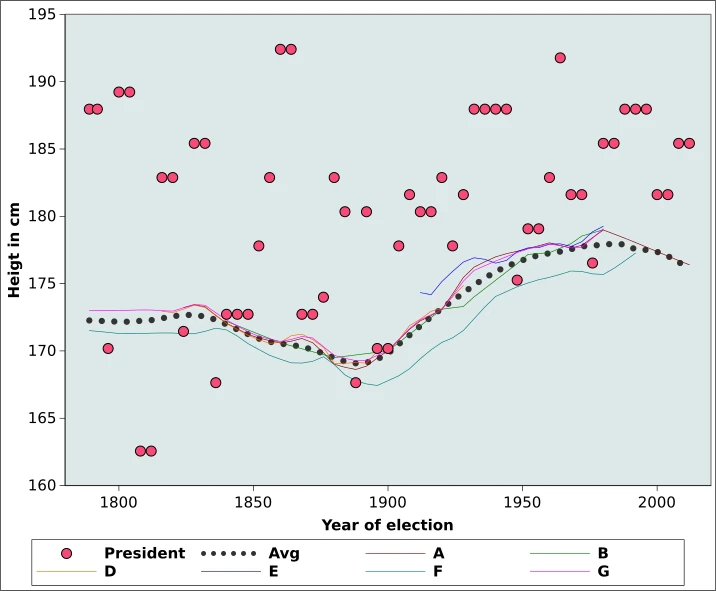
The above-mentioned Wikipedia page compares the heights of presidents and presidential candidates, and concludes that he people who made to the top are generally taller than the contenders. This, to me, is not so interesting as a comparison between the presidents and the general population, because the difference in height also indicates a difference in the peoples’ background and living conditions.
Figure 1 shows that, on average and without the need for any subtle statistics, presidents have almost always been taller than the population of white males [note 5]. Only three presidents out of 44 were more than two cm smaller than the reference population: James Madison (1808 and 1812), -9.7 cm; 1836 Martin Van Buren (1836), -4.7 cm and John Adams, 1796, almost exactly 2.0 cm below average.
3. Has there been a change over time of the difference between the height of residents and the population?
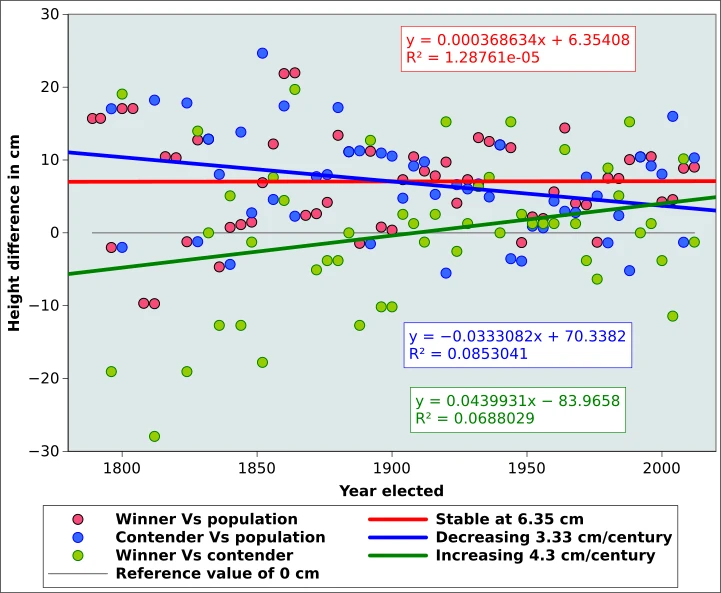
Figure 1 shows that the height of presidents (red dots) roughly follows the height of the population (dotted black line), while apparently maintaining the same distance between the two, e.g. a relative low before 1900, which is often associated with industrialisation, and the decrease starting around 1980, which is usually linked to qualitatively poor nutrition and obesity. Figure 2, especially the trend line for presidents, shows that there isn’t any trend in the height difference between them and the population. The difference has been remarkably stable at 6.35 cm over more that two centuries, indicating that the presidents have been shrinking and growing following he same pattern as the general population. I‘ll call this the 6.3 cm rule.
This can be read to mean that the same factors have affected both groups, but that the difference persisted. Based on a paired t-test, the 95% confidence interval for the difference is from 5.24 cm to 8.86 cm5.
The difference between the contenders and the reference population (blue dots and line) has kept shrinking at the rate of 3.33 cm per century, to the extent that in 50 years or so, they will be undistinguishable from the rest of the Americans… if the trend continues. As a result of the two trends, the presidents are growing taller than the contenders by 4.3 cm every century!
4. Do US presidents belong to the same group (statistical population) as the rest of the population?
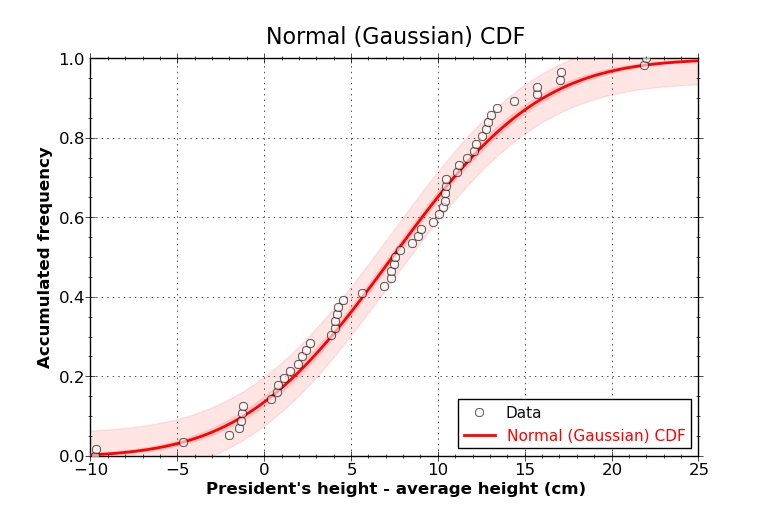
Before answering the question, i.e. before deciding if the difference between the heights of presidents and the population is statistically significant, it is necessary to check the shape of the statistical distribution.
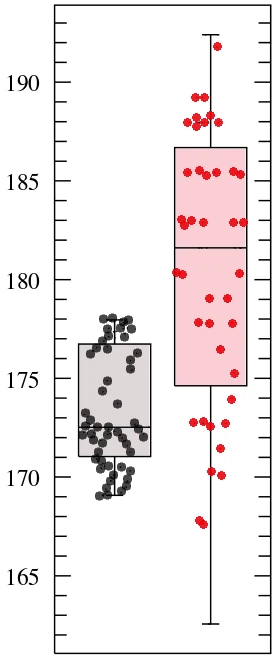
Figure 3 compares the empirical distribution with the best fit, which turns out to be Gaussian, a textbook-grade example of a normal distribution.The figure reads as follows: The abscissa (horizontal axis) expresses the difference of height between presidents and the people, positive when the president is taller, and 0 cm when they are the same height. Look up 0 cm on the abscissa and draw an imaginary vertical line up to the red line. The point of intersection corresponds to about 0.1 on the vertical axis: only 10% of presidents have been smaller than the population, which is also to say that 90% were taller.
The standard test for comparing averages of normally distributed variables is Student’s t-test. This is shown graphically in the boxplot in figure 4. The t value for an unpaired test is t= -6.71. With 112 degrees of freedom, The probability of this result, assuming the null hypothesis, is less than 0.0001. In other words, based on their heights only, there is only 1 chance in 10000 that the presidents and the rest of the American white males belong to the same population, statistically speaking. The details of the comparison are the following: general population: average height of 173.0 cm (95% confidence interval from 172.0 cm to 175.0 cm; standard deviation of 2.96 cm); presidents: average height of 181 cm (95% confidence interval from 179.1 cm to 182.0 cm with a standard deviation of 7.37 cm). The average difference thus reaches 8 cm, which is slightly larger that the value obtained from the trend graph (6.35 cm) in figure 2 above.
5. The 2016 candidates
Since the USA are the country of absolute transparency in politics, generic (e.g. year of birth, y.o.b) and biometric information is readily available from the web for both Republican and Democrat candidates (click here and here), but apparently with some uncertainty for Jim Webb – for understandable reasons: see table 2 –.
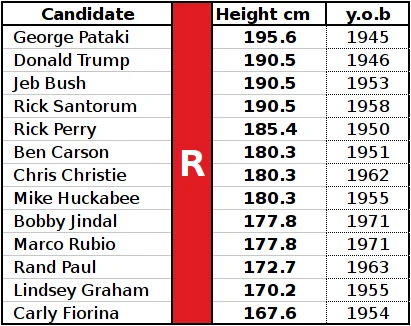
Between 2007 and 2011, the average height of white Americans males between 20 and 39 years of age was 178.4 cm, while it was 164.9 cm for white females (note 5). According to the 6.3 cm rule, the next president should thus be at least 178.4 + 6.3 = 184.7 cm. On the republican side (Table 1), George Pataki, Donald Trump, Jeb Bush, Rick Santorum and Rick Perry qualify. The next candidate, by height, is Ben Carson who’s a full 5.1 cm shorter than Rick Perry and just 1.9 cm above the national average.
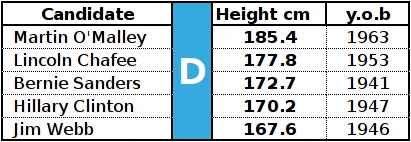
Among the Democrats (Table 2), only Martin O’Malley exceeds 184.7 cm, and the next on the list (Lincoln Chafee, who is even shorter than Ben Carson at 177.8cm) is 6 mm below the national average. Bernie Sanders is 5.7 cm below the national average; such a short candidate compared to the overall population has not been elected for almost 200 years: as mentioned: James Madison (1808 and 1812) was 9.7 cm below the average height and Martin Van Buren (1937) was he second shortest (in relative terms) with -4.7 cm in 1836. The probabilty to be elected with a height departure of -5.7 is just under 3% (see frequency graph figure 3).
I am not sure what to do with Hillary Clinton (170.2 cm) and her Republican counterpart Carly Fiorina (167.6 cm), as there are no precedents to base comparisons on for woman candidates. One approach would be to grant them a handicap equivalent to the average height difference between males and females, which is currently 13.5 cm. This would yield an adjusted height of 183.7 cm for Hillary Clinton and 181.1 cm for Carly Fiorina. Both remain below the height achieved with the 6.3 cm rule, even if Clinton is too short by just 1 cm. Maybe being a woman is worth more than 13.5 cm, particularly with high heels?
Conclusions
With a high degree of confidence, the 44 presidents from George Washington to Barack Obama do not belong to the same population as ordinary Americans: the chances of being wrong do not exceed 1 in 10,000. The presidents belong to a caste of taller than average people6 [note 7]; their height correlates with wealth, good health, long life expectancy and good education. Depending how the difference is expressed, presidents have been 6 to 8 cm taller than average, to the extent that a candidate of average height has no more than 1 chance in 10 of being elected.
Based on height (if not on stature!) the Republican offer for 2016 is overwhelming since as many as 5 candidates (George Pataki, Donald Trump, Jeb Bush, Rick Santorum and Rick Perry) satisfy the height criteria; the most qualified, by far, is George Pataki at 195.6 cm. He could be beaten only by MIchael Jordan. In contrast, the Democrats have few people sufficiently different from the average American to make it to the top: Only Martin O’Malley has a chance, possibly followed by Hillary Clinton, depending on how the height data are interpreted for women.
But one thing is certain: the winner will be reasonably good looking, wealthy, healthy and tall!
Thanks: thanks to John Timmers and Eric Brasseur for proof-reading this post.
References
Dabalen A L, Paul S 2014 Effect of Conflict on Dietary Diversity: Evidence from Côte d’Ivoire. World Development, 58:143–158.
Dion K, E Berscheid, E Walster 1972 What is beautiful is good. J Personality and Social Psychology, 24(3)285-290. Downloadable from here.
Guven C, Lee Wang-Sheng 2015 Height, aging and cognitive abilities across Europe. Economics and Human Biology 16 (2015) 16–29
Kanazawa S 2011 Intelligence and physical attractiveness. Intelligence Volume 39(1):7–14
Ludwig J 2005. Perception or Reality? The Effect of Stature on Life Outcomes. http://www.gallup.com/poll/18454/Perception-Reality-Effect-Stature-Life-Outcomes.aspx
Mehlum H, Miguel E, Torvik R 2006 Poverty and crime in 19th century Germany. J Urban Economics 59:370–388
Hamstra M R W 2014 ‘Big’ men: Male leaders’ height positively relates to followers’ perception of charisma. Personality and Individual Differences 56:190–192
Quaranta L 2013 Scarred for life; How conditions in early life affect socio-economic status, reproduction and mortality in Southern Sweden, 1813-1968. Lund Studies in Economic History 59, Lund, Sweden. 242 pp.
Additional references dated after the publication of this post
Tyrrell J, Jones S E, Beaumont R, Astley C M, Lovell R, Yaghootkar H, Tuke M, Ruth K S, Freathy R M, Hirschhorn J N, Wood A R, Murray A, Weedon M N, Frayling T M 2016 Height, body mass index, and socioeconomic status: mendelian randomisation study in UK Biobank. BMJ 2016;352:i582
http://dx.doi.org/10.1136/bmj.i582.
Notes
- The technophysio evolution is a ‘simplified form of endogenous growth theory’. It states that the ability of humans to control their environment and create technological innovations has given rise to a unique form of physiological development that has been much more rapid than previously witnessed in history. The primary conclusions of their work are that the health of one generation contributes to the strength, health and longevity of the next through mothers and the experience of infants and children; moreover, improved health and longevity allow members of that generation to work harder and longer to be able to generate resources that can, in turn, produce prosperity in succeeding generations (quote from Quaranta 2013, p.3). ↩︎
- Quaranta provides an excellent introduction to the subject of the determinants of people’s height in the first chapter of her thesis. Also consult Wikipedia. Of course genetics play a part too, as amply demonstrated by tall populations such as the Tutsi of Rwanda, the Dinka of Sudan, people from Kham (Khampas) of Tibet and the southern Slavs of the dinaric Alps. President Obama’s father was Luo, a Nilotic tribe of tall people. ↩︎
- This is reminiscent of our allegoric way of thinking and speaking. ↩︎
- There is a lot of literature on the subject of what makes men attractive to women. It should suffice to remember some examples of “trophy wives”, a syndrom examplified by JFK Kennedy and his wife Jacqueline, Prince Rainier of Monaco and Grace Kelly, Xi jinping singer Peng Liyuan, etc. The Wikipedia page mentions Nicolas Sarkozy and Carla Bruni, but also three top US politicians: Donald Trump and Melania Knauss, Newt Gingrich and Callista, and John McCain and Cindy Hensley.
↩︎ - The test was done on line. There are 57 samples for both groups. The group of presidents has a mean of 180.540526 cm and a variance of 54.293640 cm^2. The group of ordinary Americans has for mean 173.486040 cm and 8.756801 cm^2 for variance. The mean of differences is 7.054486 cm with a standard deviation of 6.817522 cm. The t value of 7.812253 with 56 degrees of freedom is significant below P=0.0001.
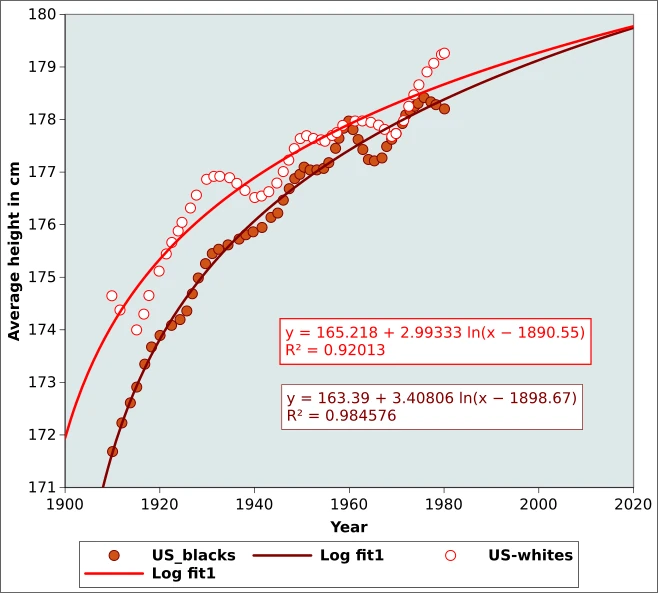
Figure Note 5: comparing the height of black US people (“US_blacks”) and whites (“US_whites”), together with the recent trend lines. ↩︎ - The word “caste” is used on purpose. The fact that the presidents are significantly taller than the population at large indicates that there is a genetic component which would not be present in a simple “class.” Even if social mobility is probably larger in the US than in many other countries (and president Obama is a perfect example) , the rich and the wealthy tend to intermarry, as is demonstrated by the many political dynasties. Well known examples are the Bush family, the Kennedy, Roosevelt and many more, including also the Adams, to quote an example from the early history of the United States. Their upbringing is also very similar and they constitute a group of people that is not unlike the more traditional European nobility. They are a perfect example of technophysio evolution! ↩︎
We all love to criticize Americans.This is the biggest world wide entertainment I have seen so far. And if you criticize American Presidents,it is superb.
When they score 353 nobel prizes, they will go the way they like.Is it not too wild?
People have criticized the American presidents for various reasons and have used different criterias, but your criteria to use a measuring tape to criticize American presidents is unique of all. Mr. Gauss never knew that you will make an invaluable and excellent use of his techniqu .
Rene! You deserve a Nobel prize for this innovative criticism.
Merci pour cette pièce, très intéressante. Au Royaume du Rwanda, la différence entre les rois (et leurs entourages) et le reste de la population était devenue tellement prononcée que certains y voyaient plutôt des origines ethniques différentes. Était-ce peut-être le résultat d’une sélection d’élites sur une très grande période (presque 1000 ans en effet)?
Pour revenir aux stars elles-mémés, on voit en fait une réduction de la variance dans les tailles des candidats présidents au cours du temps. Certes la différence entre la taille des présidents et la moyenne de la population tend a se réduire aussi, les tendances que l’on voit sur la figure 2 s’interprètent dans la logique que les “petits” n’osent plus se présenter comme candidat !!
La question du “Pourquoi” dans le titre du post ne me semble pas totalement traitée. “In a nutshell: the tallest people are tall because they grew up in more favourable environments than the rest of the population; they are also in better health, enjoy greater wealth and a higher level of education.”. OK. Nos amis Dinka devraient diriger l’Union Africaine, et concourir contre les Suédois pour les postes a l’ONU !!
Un aspect qui me semble important dans le cas des USA, c’est que la campagne présidentielle comporte une grande partie de débats et discours publics qui font jouer énormément l’apparence des candidats. Cela se voit de plus en plus, car les “petits” n’ont plus aucune chance avec la diffusion directe des images sous tous les angles.
Il me semble que, en France, ou la réussite d’un candidat dépend plus du soutien du parti, la différence de taille (!) entre les présidents et la population est probablement nulle, voire négative avec les deux derniers qui tirent la moyenne vers le bas!! Un sujet pour le prochain post???
Je suis déçu que ce soit la taille qui semble déterminante.
J’ai toujours cru que je ne pourrai jamais être président des Etats-Unis parce que j’étais incapable de répondre à des questions de journalistes tout en faisant mon footing.
Comme quoi nous sommes peu de chose.
Ne te laisse quand même pas étreindre par de trop fortes angoisses métaphysiques.
Et Trump, ne mesure rien moins que 1.91 m !
Il ne pouvait que l’emporter.CALLE MACE
Comme c’est la première fois qu’il y avait un candidate femme (dit aussi “candidate”) je pensais que, peut-être, nous aurions un effet “hauts talons” qui aurait permis de combler la différence entre Clinton et Trump.
For starters, Mr. Vucic noted wryly in an interview in the library of the presidential palace this month, “I am almost two meters tall.” That makes him about 6-foot-5. (Vladimir V. Putin is an estimated 5-foot-7 at most, though the Russian president’s exact height, a sensitive topic for the Kremlin, is a secret.)
Source: https://www.nytimes.com/2022/08/12/world/europe/serbia-vucic-russia.html
A new recent paper on the subject
Brødholt ET, Gautvik KM, Günther C-C, Sjøvold T, Holck P (2022) Social stratification reflected in bone mineral density and stature: Spectral imaging and osteoarchaeological findings from medieval Norway. PLoS ONE 17(10): e0275448. https://doi.org/10.1371/journal.pone.0275448
Here’s quote from Goliath’s Curse: The History and Future of Societal Collapse by Luke Kemp (2025): We’ve already seen that average height dropped with the move from hunting and gathering to intensified agriculture. Heights also became more variable. In the modern world, differences in wealth both within and between countries are echoed in differences in height. The poor are shorter and the rich taller. This is a historically consistent trend over thousands of years. It wasn’t just pharaohs and Mycenaean kings who were taller than their peasants: in the antebellum American South, enslaved women were 6.5cm shorter than southern white women, while the gap for men was 4cm. In contrast, Native American hunter-gatherers were fairly equal in height for both men and women. This is simply a reflection of economic inequality’s impact on health.10 Across the world, height has hovered around 170cm for the past 2,000 years. There were fluctuations, but no lasting increases until the nineteenth century. Peculiarly, as we’ve seen with both Rome and the Late Bronze Age, height tended to fall under empire and increase during periods of collapse. For human health, the idea of progress rising and falling with empire isn’t supported by the evidence.